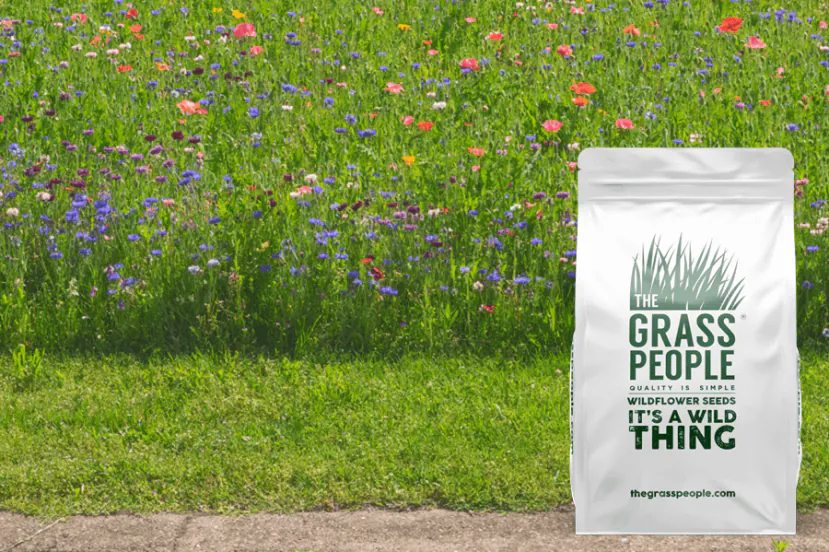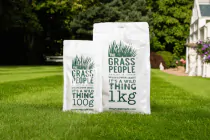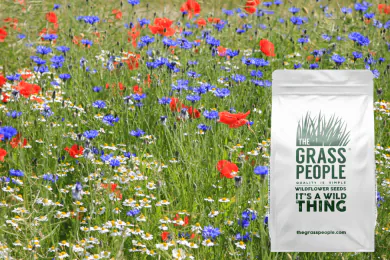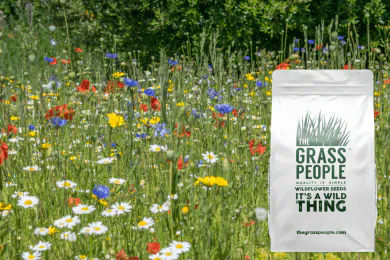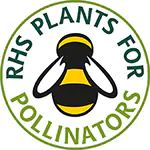Roadside & Roundabouts Wildflowers
- Contains RHS Plants for Pollinators wildflowers
- Brings wildlife back to road verges & roundabouts
- Produces vibrant and versatile flora and natural wildlife habitat
Please refresh the page in 1 minute to see the next delivery time.
How much do I need?
Simply enter the length and width of the area, to calculate how much you need.
Product Description
Our Roadside & Roundabouts mix is full of RHS Plants for Pollinators annuals and perennials and creates a long-lasting habitat for bees and pollinators on roadside verges and roundabouts. Grass within the mix creates a nursery for the wildflowers to maintain a weed-free bed and develop a habitat for wildlife for years to come. Cornfield annuals provide an instant pop of colour to tired and unkept verges and roundabouts, whilst perennials once established will not only reappear year after year but become familiar favourites to locals.
These wildflowers help to create mini meadows that when managed and maintained will save costs on mowing and remove the need for any chemical fertilisers. Containing 100% UK native wildflowers, this mix helps councils and local authorities to reclaim their road verges and roundabouts and provide nature with a local home.
For our comprehensive guide on managing wildflowers on roadside verges and roundabouts, email [email protected]. Please note, this mix is for councils and/or authorities who have permission to sow wildflower mixes in these areas.
Mixture Breakdown
June - August
What colour is it?Violet
Annual or Perennial?Annual
Latin NameCentaurea cyanus
DescriptionCornflower was previously considered a weed in amongst its cornfield annuals companions but is now accepted and widely praised as one of its finest! We're not surprised - who could dismiss those electric blue blooms?
May – September
What colour is it?Purple
Annual or Perennial?Annual
Latin NameAgrostemma githago
DescriptionCorncockle is a pretty purple wildflower with tall stems and full petals and is a bright addition to any annuals mix. It is currently rare and endangered.
June - September
What colour is it?White
Annual or Perennial?Perennial
Latin NameDaucus carota
DescriptionPart of the carrot family, Wild Carrot smells like carrots but is not the kind of one you would want to eat. Its low nutrient and drought tolerant abilities make it ideal for sandy soils.
June - August
What colour is it?Red / Black
Annual or Perennial?Annual
Latin NamePapaver rhoeas
DescriptionCorn Poppy is a vibrant and bright addition to any meadow and easily recognisable and identifiable throughout the UK. Of course it has meaning for many, and also adds a colourful pop to any wildflower plot!
June - September
What colour is it?White / Yellow
Annual or Perennial?Annual
Latin NameAnthemis arvensis
DescriptionAlthough Corn Chamomile looks like a daisy, it is part of the cornfield annuals family. With its flat and almost-level surface it makes the perfect pit-stop for bees and pollinators.
March - November
What colour is it?Pink
Annual or Perennial?Perennial
Latin NameSilene dioica
DescriptionRed Campion has hot pink petals that make for quite the show stopper in your wildflower meadow, and can typically be found in woodland areas. Red Campion begins to flower once bluebells begin to fade, so if you notice this happening in your wildflower sward you can begin to look forward to their fuchsia blooms!
May – September
What colour is it?Pink / Green
Annual or Perennial?Perennial
Latin NameSanguisorba minor
DescriptionA perennial wildflower with toothed leaves and pink flowers, its leaves when crushed smell like cucumber and used to be used in salads!
May – September
What colour is it?Yellow / Red
Annual or Perennial?Perennial
Latin NameLotus corniculatus
DescriptionBirdsfoot Trefoil is part of the pea family and grows up to 35cm. It is well known for its yellow slipper like petals and red centre, which has given it the nickname of 'Eggs and Bacon'!
May - June
What colour is it?White
Annual or Perennial?Perennial
Latin NameAnthriscus sylvestris
DescriptionCow Parsley is a shade tolerant wildflower that can be found naturally growing in woodland areas and its stem branches out into many clusters of tiny white flowers. It is sometimes referred to as 'Queen Anne's Lace' as it was said it would bloom for Queen Anne and her ladies in waiting and resembled the lace on their dresses.
July – August
What colour is it?Pink / Lilac
Annual or Perennial?Perennial
Latin NameMalva moschata
DescriptionMusk Mallow is a light pink perennial that sits open and welcome for bees to land on. It’s easy to access pollen makes it the ideal flower for attracting bees alongside its sweet musky scent that invites them to pop in for more than just a pit stop!
June - September
What colour is it?Pink / Purple
Annual or Perennial?Perennial
Latin NameDigitalis purpurea
DescriptionFoxgloves are biennial wildflowers that when sown will reward you with blooms for two whole years. Their bright pink / purple bells are attractive to bees and pollinators who tunnel in to feed on its nectar.
June - September
What colour is it?Yellow
Annual or Perennial?Perennial
Latin NameAgrimonia eupatoria
DescriptionAgrimony is a spikey perennial wildflower with buttercup-like blooms which stems can grow up to 80cm!
January – December
What colour is it?White / Brown
Annual or Perennial?Perennial
Latin NamePlantago lanceolata
DescriptionRibwort Plantain although not the brightest wildflower, certainly adds a natural diversity to your wildflower meadow. Its tiny white buds provide food for bees and pollinators whilst its seeds are great for Goldfinches.
June - October
What colour is it?Yellow
Annual or Perennial?Annual
Latin NameGlebionis segetum
DescriptionCorn Marigold is a bright ray of sunshine on a gloomy day. Its orange-yellow petals burst into life in June and last all the way through until October. Part of the cornfield annuals family, although this annual may have one showing - it’s a showstopper!
June to September
What colour is it?Pink, white
Annual or Perennial?Perennial
Latin NameSaponaria officinalis
DescriptionThis plant grows green, leafy stems that do not have any side branches. When it blooms, the flowers form in clusters of pink and white petals that produce a sweet scent.
May to September
What colour is it?White
Annual or Perennial?Perennial
Latin NameSilene vulgaris
DescriptionThis perennial plant gets its name from its bladder-like calyx with purple veins, just behind the flowers. The flowers have 5 2-lobed petals and are white in colour.
This is a grass seed and typically germinates at temperatures of 8 -10 degrees.
What colour is it?Green / Beige
Annual or Perennial?Perennial
Latin NameFestuca rubra ssp. Commutata
DescriptionChewing's Fescue is a grass that performs in most soil types
This is a grass seed and typically germinates at temperatures of 8 -10 degrees
What colour is it?Green / Beige
Annual or Perennial?Perennial
Latin NameCynosurus cristatus
DescriptionCrested Dogstail is a grass that performs in most soil types
This is a grass seed and typically germinates at temperatures of 8 -10 degrees
What colour is it?Green / Beige
Annual or Perennial?Perennial
Latin NameDeschampsia cespitosa
DescriptionTufted Hair Grass is a grass that performs in most soil types
This is a grass seed and typically germinates at temperatures of 8 -10 degrees
What colour is it?Green / Beige
Annual or Perennial?Perennial
Latin NameAgrostis vinealis
DescriptionBrowntop Bentgrass is a grass that performs in most soil types
This is a grass seed and typically germinates at temperatures of 8 -10 degrees
What colour is it?Green / Beige
Annual or Perennial?Perennial
Latin NameArrhenatherum elatius
DescriptionTall Oat Grass is a grass that performs in most soil types
This is a grass seed and typically germinates at temperatures of 8 -10 degrees
What colour is it?Green / Beige
Annual or Perennial?Perennial
Latin NameFestuca ovina
DescriptionSheeps Fescue is a grass that performs in most soil types
This is a grass seed and typically germinates at temperatures of 8 -10 degree
What colour is it?Green / Beige
Annual or Perennial?Perennial
Latin NameFestuca rubra
DescriptionSlender Creeping Red Fescue is a grass that performs in most soil types
Usage Guide
For our comprehensive guide on managing wildflowers on roadside verges and roundabouts, email [email protected]. Please note, this mix is for councils and/or authorities who have permission to sow wildflower mixes in these areas.
| Sowing Rate | 5g per m2 |
| When | For best results sow in March/April or in September |
Aftercare
For our comprehensive guide on managing wildflowers on roadside verges and roundabouts, email [email protected]. Please note, this mix is for councils and/or authorities who have permission to sow wildflower mixes in these areas.
Product Questions
Product Questions
Thank you for getting in touch.
If you are planning to sow wildflower seed, I would first recommend that wherever you plan to sow it, you remove the existing grass / any weeds that are in the area.
You can sow wildflower seed into an existing grass lawn, but it has varying degrees of success, so it isn't something we recommend. The existing grass would choke out the wildflower seeds and would eventually take over. Once you have cleared the bed of the existing grass / weeds, it is safe to sow your wildflower seed into this area. We do wildflower mixes with grass and some without - the main reason for including grass is to create a sustainable habitat for wildlife and to prevent weeds growing as the grass grows up and creates a nursery for the wildflowers.
If you are looking for ornamental wildflowers (just for show) they provide a habitat for bees and pollinators while they are in bloom but not throughout the year.
